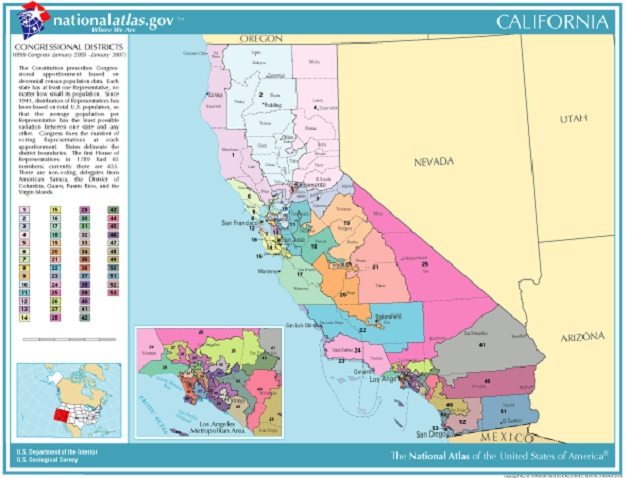Flap’s California Morning Collection: June 8, 2011 Redistricting Edition

Amid growing scrutiny of a draft plan for the state’s congressional redistricting, an update draft released today restores a key chunk of Rep. Loretta Sanchez‘s Democratic Latino district. That district had been virtually eliminated in a previous draft.
However, the new map – which will face additional revisions – shows a Sanchez district that is more evenly balanced between Democrats and Republicans than the current configuration.
The latest configuration could set up a showdown between Latino and Vietnamese-American voters. The proposed boundaries shows a population with 32 percent Latino citizens of voting age and 28.4 percent Asian citizens of voting age. Asians – including Vietnamese-Americans – historically turn out to vote in higher percentages than Latinos.
The latest map, which is being reviewed today by the California Citizens Redistricting Commission, could also set up a dogfight between GOP Reps. Dana Rohrabacher and John Campbell. The map puts the biggest cities in Rohrabacher’s current district – Huntington Beach and Costa Mesa – in the same district as the biggest cities in Campbell’s current district – Irvine and Newport Beach.
California Citizen’s Redistricting Commission: Map Revisions for June 7, 2011
Zipped PDF Files for AD Region I, II, and III Visualizations (zip, 1.9MB, June 7, 2011)
Zipped PDF Files for AD Region IV Visualizations (zip, 7.4MB, June 7, 2011)
Zipped PDF Files for AD Region V, VI, VII, VIII, and IX Visualizations (zip, 2.2MB, June 7, 2011)
Additional PDF File for AD Region V, VI, VII, VIII, and IX Visualizations (zip, 1.1MB, June 7, 2011)
Zipped PDF Files for SD Region I, II, and III Visualizations (zip, 859kB, June 7, 2011)
Zipped PDF Files for SD Region IV Visualizations (zip, 2.4MB, June 7, 2011)
Zipped PDF Files for SD Region V, VI, VII, VIII, and IX Visualizations (zip, 1.4MB, June 7, 2011)
Zipped PDF Files for CD Region I, II, and III Visualizations (zip, 1.9MB, June 7, 2011)
Zipped PDF Files for CD Region IV Visualizations (zip, 1.3MB, June 7, 2011)
Zipped PDF Files for CD Region V, VI, VII, VIII, and IX Visualizations (zip, MB, June 7, 2011)
Redistricting threatens to throw San Francisco politics into chaos
San Francisco will lose power in state government. A portion of The City could be unrepresented in the state Senate for two years. And a host of career politicians’ futures are flailing wildly in the winds of redistricting.
Those are the wild possibilities confronting San Francisco’s political leadership this week, after the first peek at how the state’s independent Redistricting Commission — California’s first-ever attempt at politics-free district drawing — may reapportion the lines of power in California.
The commission released “visualizations” of the new districts for California’s Senate, Assembly and the U.S. Congress this week. If the lines they reveal remain even roughly the same as those drafts undergo revisions in coming months, San Francisco will lose a state Senate seat, a potential blow to The City’s influence in the Legislature.
Opinion: Redistricting turns up heat on Latinos, other minorities
The state’s 2011 redistricting process reached a milestone in late May when the new California Citizens Redistricting Commission completed accepting public testimony before it releases drafts of new lines for the state’s Assembly, Senate and Congressional districts. The final hearing, which included formal presentations by civil rights organizations, was preceded by a series of public hearings throughout the state, many of which were unevenly attended.
This new redistricting process, in which the task of redrawing the lines was removed from the state legislature by Propositions 11 and 20 and placed in the hands of a 14-member Commission, is intended to eliminate incumbent protection interests and partisan politics. Based on the hostility exhibited at several hearings toward some Latinos and other minorities, and the line of questioning of the civil rights organizations by some of the Commissioners at the final hearing, it appears that this redistricting process may become mired in a different kind of politics. The public should take note.
The Commission has been hampered in its work by an insufficient budget. As a result, the Commission conducted only limited public outreach of its own, relying on scant coverage by the news media and the outreach by a handful of organizations to get the word out to traditionally underrepresented communities. Not surprisingly, the public testimony has been imbalanced, with traditionally engaged voters actively participating, and many underrepresented communities relying on the efforts of statewide and national organizations to represent their interests.
At several hearings, Latino community leaders in attendance often bore the brunt of the animus from those who objected to the Commission’s legal mandate to ensure compliance with the federal Voting Rights Act (VRA). The VRA prohibits the vote dilution of Latinos, African Americans, Asian Americans and other protected voters, and requires that districts be created where these groups can comprise the majority of voters. Vote dilution occurs by over concentrating or fragmenting politically cohesive and geographically compact minority communities. The Commission is required to make VRA compliance the second most important criterion it employs, second only to equalizing population among the districts.
Enjoy your Morning!